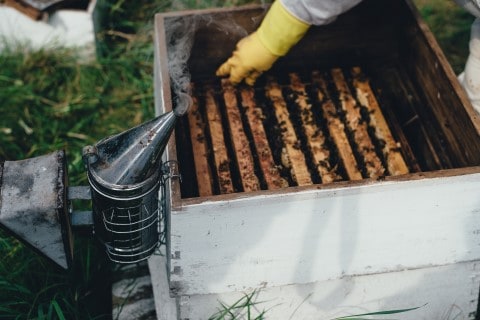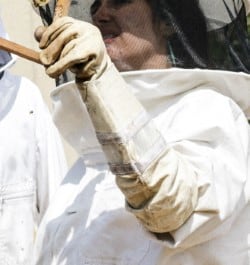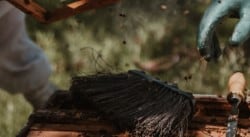Bees are fascinating creatures. They are hard workers and are very efficient in what they do. We humans rely on the pollinating power of the bees who help us have a variety of food that we consume every day. It is why experts consider bees as beneficial insects and a key species in our environment.
Knowing that these little creatures play a vital role in our ecosystem, gives us a better understanding of how we should address them when they set up residence in places that are very inappropriate such as inside your home or anywhere near your house.
Yes, they do sting but with the extreme decline in their population due to a number of causes government officials have now mandated that bees should be protected as part of the ongoing rehabilitation of the key pollinators of the planet.
Table of Contents
Should you remove a beehive/nest?
This depends on the kind of bees that took up residence and where they made their hive.
Location
The location of the nest should be considered before you decide if it is necessary to remove the hive. If the bee colony took up residence inside your house or in any place that poses risks of people getting stung, then removal of the hive/nest is necessary.
Places such as children’s playgrounds, parks, and home gardens are among the places that warrant immediate removal of the hive. This decision is not only for the sake of the humans that frequent the area but also for the bee’s benefits. Imagine these creatures, continually defending their home from threats, add the fact that bees can only sting once and then they perish right after, then you will understand that the removal and relocation of the beehive or nest is a win-win decision.
Now, if the hive is located in a place where there is very seldom human traffic, then it is more practical to leave the nest alone. It is best to let the beehive thrive in the area because they need all the help they can get nowadays.
Type of Bees
Honey bees are the ones that produce honey in their hive and they are also the ones that need to be addressed right away. If you see bees setting up residence in your area, call the experts immediately to have them remove it. Your safety is important and that is why it is best to call experts because dealing with bees needs proper equipment and training.
Species such as bumblebees don’t produce honey. The bumblebees need not be dealt with because they are very docile and is very unlikely to cause distress. If you’ve successfully identified that the bee that is circling you is a bumblebee, then there is no need to call the experts. The best step for you to take is to leave it alone. They do not form large colonies as the honey bees do. It is understandable to remove honey bee hive/nest but the bumblebee nest should be left alone. Their nest lasts only one season, so it is better to wait it out.
In the case of Africanized Honey Bee species, you will certainly need to call experts to handle them. These species of bees are the same infamous bees that are called “killer bees” because of their very aggressive character. They are easily riled up and are more ready to sting than any other species. They attack in large swarms and victims usually suffer double the number of stings compared to regular honey bees. Proper care and safety need to be employed when removing nests and hives of this bee species.
Will the bees be hurt if you remove the hive/nest?
Bees may get disoriented when removed from their habitat. After all, they get smoked most of the time when they are relocated. However, they do not get hurt at all. Yes, there may be casualties but it is very minimal considering that they are more in danger from other outside influences if not moved.
Large nests will need to be dealt with people who have experience and training for this kind of undertaking. Most professionals would opt to relocate the hive rather than killing them because of the decline in the population of bees. Many states have issued mandates stating that beehives should be saved rather than destroyed.
There are cases of mistaking bee swarms for bee hives. Seeing a swarm can be frightening but rest assured that these swarms are not out to get you. They are merely there because they are looking for a new location to establish their colony. These swarms may contain 5,000 to 20,000 bees and they fly in a cluster until they locate a suitable nesting site for which they can set up shop. They are easy to deal with and most experts don’t charge much when dealing with bee swarm, with the exception of Africanized honey bees.
A beehive, on the other hand, is far more complicated to deal with especially if the hive is located in a very inconvenient area like an unused chimney, hollowed out trees, or in any dark cavities. When this happens, experts will surely charge you with a fee for the removal. It is also normal that some stragglers will be left behind after the removal of the hive. This cannot be helped since worker bees always forage. These stragglers will eventually die as soon as they realize that their queen and hive is no longer present.
Are there home remedies for getting rid of bees?
Large colonies and hives need an expert to be removed. The smaller ones, on the other hand, gives you a choice, you can let the experts do it or you can do it yourself.
A natural way of dealing with small bee nests is to trap the bees and then remove the nest. Place the nest in an area where there is less human activity and then release the colony. Always wear protective clothing when dealing with bees to avoid getting stung. Now that bees are under the protection of the government, it is better to find alternatives in dealing with them. The use of pesticides and insecticides to remove bees is now not recommended. Even pest control experts are working together with beekeepers on this project.
Try using mothballs, DIY bee repellent spray, or cinnamon to drive away the bees in your vicinity. Strong smelling plants like peppermint or any mint variety will help you keep bees away. It is strongly recommended that you don’t kill bees from now on, they are in dire need of our help.
Step by Step Guide on How to Remove Bees Nest Ethically
If a bee nest is located in an inconvenient location, the best course of action is to call the experts to relocate them. The removal of the beehive/nest is easy when the nest is located in an area where it is easily ccessible and challenging if the little buzzers have set up shop somewhere inside your home walls.
These steps are what experts usually take when dealing with bees.
- Locate the nest/beehive. If it is inside a wall, they determine where the edges of the hive are. If it is outside, then they decide which strategy is best to approach the nest.
- Once the hive is located and a strategy is chosen, they proceed by putting on protective clothing and prepare other tools they need for the removal of outside beehives. For beehives within structures, they also put on protective clothing and then proceed to cut out a big enough hole near the nest to access the hive.
- Once the nest/hive is accessible, the experts either start vacuuming the bees or smoking them first if they get agitated. Note that the vacuums that are used during this process are outfitted with an additional box where the bees are deposited unhurt when sucked in.
- Honeycombs are then removed and put inside a container where it can be transported. Some of the combs will be given back to bees to help them overwinter and to ensure that they have enough brood to survive the next season.
- The gathered bees are then transported to a beekeeper along with the combs. The beekeeper will then set-up a new hive box for the new bee colony to inhabit.
- Supplementary food will be given to the new colony to ensure that they survive until next season.
As you can see, there is a better way of addressing the bees in your home or garden. There is no need to resort to killing these key species of our world.
Can I start my own bee colony from the beehive I removed?
Starting your bee colony can be a costly decision but with the recent problems that our bee species are facing, that decision is a very considerate choice.
Yes, you can start your own colony from the beehive you removed especially if the beehive belongs to a honey bee. In fact, many are already practicing this activity. The beehives that are collected from private properties are moved to locations where they have the chance to thrive. Beekeepers encourage many to do the same to help the bees population from further declining.
Keep in mind that keeping the colony from the beehive will mean that you have to fork out some cash to give them a better chance of survival. You may also need to be trained in the proper handling of bees and to know when and where you should place your hive box. Organic farmers are being encouraged by the government to help out the bees by making their farm available to house an apiary if possible.
Here are some of the equipment you will need to own if you plan to keep the colony of bees you just removed from your property.
Hive tool
This is a piece of critical equipment when it comes to beekeeping. Bees use resin-like propolis to glue everything in their hive together. The hive tool works by helping you pry this resin-like propolis from the comb for easier detachment of the frames. Choose one that has a built-in comb knife on the other end to eliminate carrying two different tools (hive tool and comb knife).
Smoker

This is a tool that all beekeepers must have because it is very invaluable especially. It helps beekeepers deal with aggressive bees because the smoke makes the bees a lot more docile and easier to work with. It masks the scent of the alarm pheromone that guard bees release, therefore, lowering your chance of getting stung.
A bit of trivia, honey bees releases an alarm pheromone when agitated and disturbed. This pheromone smells like banana candy. So while you are working on a hive and you smell bananas out of the blue, you know that it is time for another puff of smoke.
Jacket with hat veil
This is an item of protective clothing that should be purchased along with your hive box. It is an article of protective clothing that prevent bees from stinging you while you work with them. Some are very comfortable working with bees without protective clothing but since you are a beginner we suggest that you buy a jacket with hat veil or even just a hat veil.
Another trivia, bees often fly towards your face or sting your face area because they smell the carbon dioxide we humans exhale as we breathe.
Gloves

A sturdy yet flexible one is the best kind. Gloves made from leather would be ideal for beekeeping. One that fits snuggly enough so that you have better control and grip on your hive tool or smoker as you work on your beehive. It is a piece of protective clothing gear that will also prevent stings from your honey making friends.
Bee Brush

When used properly, this is a very valuable tool. It can help you brush off bees from frames without hurting them. It can also be used to brush off bees from your clothing when they swarm on you.
Hive Box
Last but still is the most important one is the hive box. Your bees will need a home where they can protect their queen, produce offspring and of course, store the honey. The hive box offers all that to the bees and more. A hive box is also a way for bees to have a fighting chance against the weather.
Here are three types of hive boxes that you can choose from.
Langstroth Hive
Developed by Reverend Lorenzo Lorraine Langstroth from Philadelphia in 1851. This is the most common set up you will see. They are the white boxes stacked one on top of the other with a protected roof for ventilation. You can choose between a 10-frame or an 8-frame hive.
This is actually the universal standard in beekeeping because of its ability to produce larger quantities of honey. It is an “old school” technology as many would say but it still is the most common system used by beekeepers.
Please our other article on this particular hive: https://schoolofbees.com/in-praise-of-the-langstroth-hive/
Top-Bar Hive
People who use this system are mostly backyard enthusiasts or organic farmers who prefer a more natural and sustainable approach. A set of horizontal bars are placed across a hive with a shape of a watering trough. It is then topped with a protective cover to ensure that bees use the built-in entrance for the hive. These horizontal bars is where the bees will create their combs going downwards, which is like mimicking the same process they go through if their nests are located in their natural environment.
It is an inexpensive system and is very natural for the bees. It offers less disruption to the bees during an inspection and is perfect for those who prefer a more laid back approach.
Warré Hive
Developed by Emile Warré from 1867 to 1951, is a cross between the Langstroth Hive and Top-Bar Hive. Stacks of small white boxes, very similar to that of Langstroth Hive, with top bars that are placed across the top where bees can hang their combs like that in a top-bar hive. The cover of this hive is very differently constructed compared to the previous two. A quilt that is filled with wood shaving or sawdust together with an angled roof for better air flow is what makes the cover of this system.
As the colony grows and more combs are made, additional boxes can be added at the bottom to create more space. It is a very natural system for bees because it has no foundation. It also requires less inspection, which allows the bees to thrive naturally. However, this system is not legal in some areas to make sure that you ask your local beekeeping community if you can employ this one.
Conclusion
Beehives can be found in places that might be “inconvenient” to humans. It is what prompts many into thinking that they need to be dealt with. If you are one of the lucky ones to have found a beehive, then you need to determine if the species of bees you see is an aggressive one that poses the risk of humans getting stung or a species that is best left alone.
Removing the beehive from the area can help the bees in their fight for survival only if it is removed the right way (without the use of chemicals). There are ways to remove the beehive and still save the colony, call your local experts for help. Now that it is clear to you that there is an ethical way of removing beehive/nest, you now have the knowledge that gives you the chance to help these creatures from the further decrease in their population.

I appreciate the advice on identifying the type of bees in a hive before trying to remove them. There is a big hive in one of the corners of my roof. I’ll have to contact pest control so that they can identify what species the bees are.
I’m glad to hear that professionals can safety remove beehives without harming them. There is a beehive on my porch that makes me nervous and uncomfortable, but I understand how important bees are to the ecosystem. I will definitely contact a pest control team who can safely relocate it.
It’s great to hear someone being so considerate and not just running to the store to buy chemicals. Thank you!
I love how you said that you should call experts to move a beehive if it is an inconvenient location. People that don’t have the proper equipment should not go near the beehive. Moving a hive without professional equipment could get yourself extremely harmed. Thanks for helping people realize when they should call for a professionals help.
Thank you for your tip to use mothballs or strong smelling plants like peppermint to get keep bees away. It makes sense that it’s a good idea to leave getting rid of large beehives to the professionals. Last week, my brother found a large beehive on the edge of his property that he wants to get rid of before it starts getting any bigger. I’ll recommend these tips to him so the bees can be removed and everyone can stay safe.